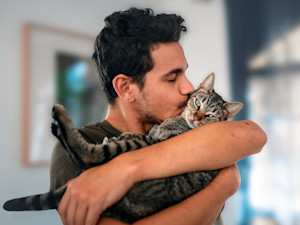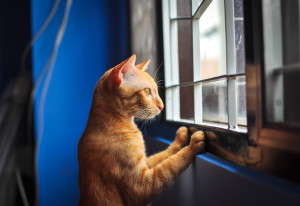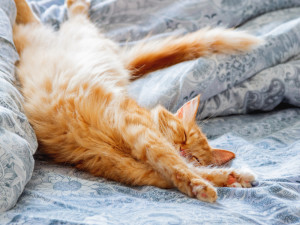Can Cats Have Panic Attacks?
How to know something more serious isn’t going on.

Share Article
In This Article:
Panic Attacks vs. Heart Attacks Signs of Anxiety in Cats What Causes Anxiety or Panic Attacks in Cats? How to Calm an Anxious Cat When to Seek Veterinary Help for Cat Anxiety
Many of us use the term “having a heart attack” figuratively to describe feeling sudden shock or surprise, but we don’t literally mean that there is something wrong with our hearts. In most cases, the same is true for cats. Cats can and do experience anxiety and panic ranging from occasional, minor episodes of stress to more severe, chronic forms of anxiety or panic. Sometimes, these feelings are the result of triggers in their surroundings, while other times they may be related to previous experiences or behavioral conditions.
Fortunately for us and our favorite felines, true medical heart attacks are extremely rare in cats. There are other medical conditions that can cause similar signs to anxiety, however, so it is important to speak to your vet if you are concerned that your cat is showing these signs. Read on to learn more about anxiety and stress in cats, how that can manifest in many different ways, and how you can help your kitty through these episodes.

Panic attacks vs. heart attacks
Humans and cats are different in how they experience conditions caused by anxiety as well as medical conditions related to the heart. While in humans it is common for there to be a lot of similarities in the signs of a panic attack and a heart attack including shortness of breath, chest pain, and a fast heartbeat, this is not the case for cats.
Heart attacks in humans are caused by the blockage of a critical artery that supplies blood to the heart, leading to damage to the heart muscle, known as a myocardial infarction. This same condition rarely occurs in cats. While cats can experience other kinds of serious heart and breathing problems, the signs associated with these conditions are less likely to resemble the signs of fear or panic in cats. Some of the most common signs of each condition include:
How to identify stress in cats
Signs of stress in cats can vary, especially when comparing short-term stress versus chronic stress. We often look at a cat’s body language for signs of fear in the short-term. Cats that feel stressed or scared may have dilated pupils, puffed up fur on their back or tails, a crouched position, and ears that are back or flattened out to the sides.
They may also meow frequently, growl, hiss, try to run away, or become aggressive by trying to swat or bite if they feel trapped. When they remain in a stressful situation for days, weeks, or longer, they may hide, stop eating, have accidents outside the litter box, lose interest in playing and socializing, develop recurring medical problems, or become aggressive.
How to identify panic in cats
Panic is a more extreme form of stress triggered by an intense fear response that usually only lasts a few minutes. In humans, panic attacks have the unique distinction of occurring in the absence of an actual threat, and they are defined differently from a person’s response to a real-time danger. In cats, this difference may not be as clear if a cat perceives something to be a true threat even if it isn’t, such as a vacuum cleaner or your family’s new puppy.
Signs of panic resemble the signs of acute stress that are triggered by the flight or fight response. Cats who are panicked will have dilated pupils, rapid breathing and heart rates, elevated body temperatures, puffed up fur on their backs and tails, and ears that are flat back or to the sides. They may attempt to run away from a perceived threat, hide, or become aggressive if they can’t escape. Some cats may vomit, pee, or poop when they are in a state of panic as well.
Signs that a cat is having a heart attack
The good news is that it is so extremely rare for a cat to have a true heart attack that this is very unlikely to be the explanation for your cat’s physical or behavioral signs. Cats can develop other severe, acute heart or breathing problems related to complications of an arrhythmia, blood clots, heart failure, asthma, respiratory infections, or cancer.
In these cases, there are often gradual signs of illness that precede the crisis. This may include weight loss, decreased appetite, lethargy, abnormal breathing, or coughing. In an acute crisis, cats with heart or breathing problems may breathe very quickly or with their mouth open as if they are panting, collapse or be unable to walk, have dark red or blue-tinged gums, feel cold on their extremities like paws and ears, or meow like they are distressed. All of these signs should be considered a medical emergency and require immediate veterinary attention.
Signs of anxiety in cats
The signs of anxiety in cats can vary depending whether they experience a limited, short term trigger or if they are living in a stressful situation long-term. Anxiety can manifest with both physical and behavioral signs including:
Physical signs: In an acutely scary situation, cats will show a fear response that includes dilated pupils, rapid breathing and heart rates, elevated body temperature and changes in their body language. Cats who are living in a long-term stressful situation may also experience vomiting, diarrhea, urinary problems like sterile cystitis, aka bladder inflammation, or recurrent respiratory infections.
Behavioral signs: When cats feel anxious, they may choose flight or fight behaviors. Some cats try to hide and run away while others may become aggressive and growl, hiss, swat, or bite at a perceived threat. Many cats vocalize and meow when they feel stressed, too. Cats who are in a long-term stressful situation often experience behavior changes like hiding for long periods of time, sleeping more, loss of appetite or overeating, inappropriately peeing or pooping outside the litter box, overgrooming themselves, or avoiding socialization and playing.
Subtle clues: Some of the less obvious signs of stress include changes in appetite, avoiding certain parts of the home or activities that may be a trigger, becoming less playful or more irritable, or sleeping more. If these signs happen very gradually and are not extreme, it may be hard to pick up on them at first, especially if they coincide with other big changes at home that require your attention.
What causes anxiety or panic in cats?
The most common causes of anxiety or panic in cats are triggers that a cat perceives as dangerous or threatening. Cats may also become distressed by changes in their routine and from a lack of healthy outlets for mental and physical enrichment. Other times, cats may show signs similar to anxiety that are related to health problems or more serious behavioral and neurologic conditions. This includes:
Environmental triggers
Even though cats are fierce predators themselves, they are also potentially prey to bigger animals and have to be ready to protect themselves from danger. Some common triggers for cats include unfamiliar animals like dogs or stray cats, loud noises, feeling trapped or cornered, and unfamiliar people and places.
Past experiences
We know cats are super smart so it’s no surprise that they may remember previous trauma and react accordingly. If a cat has a stressful experience at the vet for example, they may become stressed whenever they have to go into that same carrier, or in the car, or at the vet’s office.
They may become stressed and avoid people who previously scared them or mishandled them, or avoid certain parts of the house where they had a bad experience previously. Cats who were not well-socialized as kittens and exposed to lots of different people, noises, smells, and other stimuli may also be more generally fearful and anxious.
Health Issues that can mimic anxiety
Some health conditions can cause cats to behave as if they are more anxious, or show signs that may mimic anxiety. This includes hyperthyroidism, cognitive dysfunction, respiratory conditions, heart conditions, urinary tract problems, or digestive problems. Cats who are sick in any way may truly feel more stressed and anxious, too, so they may have a combination of physical illness, distress, or anxiety.
Behavioral disorders
Some cats may have a more specific behavioral or neurological condition that includes signs of anxiety but also have unique features that don’t quite fit with the typical pattern. In these cases, there may not be an obvious trigger, and the signs they show may be more extreme or prolonged than a typical fear response.
Examples of this include feline hyperesthesia syndrome, focal seizures, certain toxins, or redirected aggression. It can be very helpful to record a video of these episodes so your vet can assess what’s going on.
How to calm an anxious cat
The most effective ways to calm an anxious cat will be to understand their triggers and help minimize them or desensitize your cat to them over time. In the short-term, there are also many steps you can take to help your cat feel safe and to promote their overall physical and mental health.
For cats in a state of panic, be sure to also keep your own safety in mind as they may become aggressive and unintentionally hurt someone in their attempt to flee or protect themselves. Some general suggestions for reducing stress and anxiety include:
Create a safe space: Cats should always have access to a safe space in your home. Ideally this is a quiet, private area where other people and animals can’t reach them. It may be a high perch like a cat tree, or a room with a kitty door that is otherwise closed off. This allows your cat to retreat if they feel scared and take time to calm down without feeling trapped. Just be sure your cat can freely come and go and has access to food, water, and a litter box.
Use calming products: Pheromone sprays and diffusers are designed to mimic the chemical messages secreted by nursing mother cats to help calm their kittens as well as happy cats who rub their faces on people and objects. These pheromones may help cats to feel more comfortable in their surroundings and reduce stress.
Engage in play and routine: Cats love a reliable routine so they know when it will be meal time, play time, and time to clean their litter box. Try to stick to a consistent schedule so your cat can rely on that routine and feel confident about when these things will happen. Regular play, physical exercise, grooming sessions, and mental enrichment activities are also crucial to your cat’s mental health. Building these activities into their daily routine also ensures that they have healthy outlets for their needs and will help to prevent boredom, depression, anxiety, obesity, and destructive behaviors.
Avoid triggers: Whenever possible, do your best to minimize triggers that you know scare your cat. If you cannot completely avoid them, try to give your cat a safe space as far from their triggers as possible, and work to slowly desensitize your cat to triggers that will be unavoidable.
Prescription medication: For cats who have more severe, chronic anxiety, or for situations where your cat has to be in a scary situation such as travel, or vet visits, it is a good idea to consult your veterinarian about appropriate medications that may be safe and effective. These may be medications that you give daily for chronic anxiety, or one-time medications that can be used during a stressful event. The goal is to reduce your cat’s anxiety enough to bring them much needed relief, prevent more serious complications from chronic stress, or allow them to be safely handled during a stressful event.
When to seek veterinary help for anxiety, panic, or heart problems
Many times, veterinary support will be extremely helpful in managing cats with behavioral issues like anxiety or panic, as well as with medical concerns. In any situation where you feel concerned for your cat’s wellbeing, it is best to seek veterinary help in order to get the most accurate guidance on a diagnosis and treatment options. There are some situations where the need for professional veterinary help is especially important including:
Persistent symptoms: Cats who have ongoing signs of anxiety, or frequent bouts of panic-like episodes really need relief and the longer they are stressed, the more at risk they are for secondary health problems. It is important to seek out effective treatments and to have your cat screened for related medical conditions.
Severe behavioral changes or physical signs: If your cat’s behavior seems extreme, such as injuring themselves or others during episodes of extreme anxiety, destructive behaviors, or stress that is accompanied by physical changes like not eating, diarrhea, or peeing and pooping outside the litter box, it is especially important to seek professional help for your kitty. This will avoid worsening complications and protect your wellbeing and your cat’s. The same is true if you are concerned about a medical problem such as a heart condition, which may require more frequent monitoring, medications, or specialized tests.
Explore treatment options: If you’ve tried the do-it-yourself approaches to reducing your cat’s anxiety but you still don’t feel like your cat is at ease, your vet can be a very knowledgeable resource. They may have other suggestions to try, as well as access to other tools like prescription medications, and contacts for veterinary specialists like neurologists as well as local trainers and behaviorists.
Bottom line
Cats experience stress and anxiety in many different ways but they do not have classic panic attacks as they are defined for humans
There are medical conditions that can mimic or overlap with the signs of anxiety in cats, however, heart attacks are extremely rare in cats and are a likely cause of these signs in cats
There are many effective ways to reduce stress and anxiety in cats; be sure to see your veterinarian if your cat has extreme signs of anxiety or you need guidance in how to best help your cat
References
Buffington, CA and Bain, M, “Stress and Feline Healthopens in new tab,” Veterinary Clinics of North America Small Animal Practice, 2020, vol. 50, no. 4, pp. 653-662.
Cackovic, C, et al, “Panic Disordersopens in new tab,” StatPearls, January 2025.
Guillaumin, J, “Feline Aortic Thromboembolism: Recent advances and future prospectsopens in new tab,” Journal of Feline Medicine and Surgery, June 2024, vol. 26, no. 6.
Rodan, I, et al, “AAFP and ISFM Feline-Friendly Handling Guidelinesopens in new tab,” Journal of Feline Medicine and Surgery, May 201, vol. 13, no. 5, pp. 364-375.

Dr. Amy Fox, DVM
Amy Fox, DVM is a small animal veterinarian in New York City with over thirteen years of experience in a mixture of general practice, emergency medicine, and shelter medicine. A lifelong animal lover, Dr. Fox studied biology in college and then worked as a veterinary nurse before pursuing veterinary school at Cornell University. Her expertise includes surgery, dentistry, and management of chronic conditions, and she is interested in toxicology, pain management, nutrition, care of senior pets, and educational outreach. Dr. Fox also enjoys writing about veterinary medicine and teaching, and her work has previously appeared in Spruce Pets. In her free time, she loves to cook, garden, go for long runs, and hang out with her goofy mixed-breed dog May, who provides never ending comic relief!
Related articles
![orange cat looking out window]()
Is Your Cat’s Separation Anxiety Ruining Their Life and Yours?
Why your cat freaks out when you’re away (and how to help).
![Red cat with squinted eyes laying in a basket closeup]()
6 Ways Your Cat Could Tell You They Are in Pain
Here are all the way your kitty is trying to tell you they’re hurting.
![Cat stretching on blue bedding]()
5 Calming Products for Cats
Because New Year’s Eve is never a silent night.
![Cat looking at human]()
Does Your Scent Actually Help Calm Your Cat?
They want you around more than your sweaty T-shirt in their carrier, but thanks for the thought.
Why Does Your Cat Run Away From You?
Cats may be curious creatures—but we have some answers.






